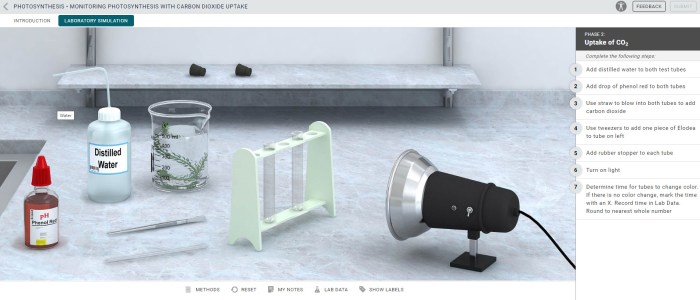Photosynthesis monitoring photosynthesis with carbon dioxide uptake stands at the forefront of understanding plant physiology and environmental processes. By delving into the intricate mechanisms of photosynthesis and the role of carbon dioxide uptake, we unravel the secrets of plant growth, ecosystem health, and the impact of environmental factors on these vital processes.
This exploration will illuminate the methods employed to monitor photosynthesis, showcasing the significance of gas exchange analysis systems and chlorophyll fluorescence techniques. Furthermore, we will delve into the practical applications of photosynthesis monitoring, highlighting its invaluable contributions to agriculture, environmental research, and biotechnology.
Photosynthesis Process
Photosynthesis is the process by which plants and other organisms use sunlight to convert carbon dioxide and water into glucose and oxygen. It is a vital process for life on Earth, as it provides the food and oxygen that we need to survive.
Mechanism of Photosynthesis
Photosynthesis occurs in two stages: the light-dependent reactions and the light-independent reactions. The light-dependent reactions take place in the thylakoid membranes of chloroplasts, and they use light energy to split water molecules into hydrogen and oxygen. The hydrogen atoms are then used to reduce NADP+ to NADPH, and the oxygen atoms are released as a waste product.
The light-independent reactions take place in the stroma of chloroplasts, and they use the ATP and NADPH produced by the light-dependent reactions to fix carbon dioxide into glucose. The first step in the light-independent reactions is the fixation of carbon dioxide by the enzyme ribulose 1,5-bisphosphate carboxylase/oxygenase (Rubisco).
Rubisco adds carbon dioxide to a molecule of ribulose 1,5-bisphosphate (RuBP), forming two molecules of 3-phosphoglycerate (3-PGA).
The 3-PGA molecules are then reduced to glyceraldehyde 3-phosphate (G3P) by the enzymes glyceraldehyde 3-phosphate dehydrogenase and glyceraldehyde 3-phosphate kinase. The G3P molecules can then be used to synthesize glucose or other organic molecules.
Role of Chlorophyll and Other Pigments
Chlorophyll is a green pigment that is found in the chloroplasts of plants. It absorbs light energy from the sun, and it uses this energy to drive the light-dependent reactions of photosynthesis. Other pigments, such as carotenoids and phycobilins, also help to absorb light energy and protect the chlorophyll from damage.
Carbon Dioxide Uptake in Photosynthesis

Carbon dioxide is essential for photosynthesis, as it is the source of the carbon atoms that are used to build glucose. Carbon dioxide enters the leaves of plants through stomata, which are small pores on the surface of the leaves.
Role of Stomata
Stomata are regulated by guard cells, which open and close the stomata in response to changes in the environment. When the environment is dry, the guard cells close the stomata to prevent water loss. When the environment is humid, the guard cells open the stomata to allow carbon dioxide to enter the leaves.
Role of Rubisco
Rubisco is the enzyme that fixes carbon dioxide into glucose. Rubisco is a very slow enzyme, and it is often the limiting factor in photosynthesis. The rate of photosynthesis can be increased by increasing the concentration of Rubisco in the leaves.
Calvin Cycle, Photosynthesis monitoring photosynthesis with carbon dioxide uptake
The Calvin cycle is a series of reactions that use the ATP and NADPH produced by the light-dependent reactions to fix carbon dioxide into glucose. The Calvin cycle is a cyclic process, and it can be divided into three stages: the carbon fixation stage, the reduction stage, and the regeneration stage.
In the carbon fixation stage, carbon dioxide is added to RuBP by Rubisco. In the reduction stage, the 3-PGA molecules produced by the carbon fixation stage are reduced to G3P. In the regeneration stage, the RuBP molecule that was used in the carbon fixation stage is regenerated.
Monitoring Photosynthesis

Photosynthesis can be monitored using a variety of methods. The most common method is gas exchange analysis, which measures the rate of carbon dioxide uptake and oxygen release. Other methods include chlorophyll fluorescence techniques, which measure the fluorescence of chlorophyll molecules when they are exposed to light.
Gas Exchange Analysis Systems
Gas exchange analysis systems measure the rate of carbon dioxide uptake and oxygen release by plants. These systems typically consist of a chamber that is sealed around a leaf or plant, and a gas analyzer that measures the concentration of carbon dioxide and oxygen in the chamber.
Gas exchange analysis systems can be used to measure the rate of photosynthesis under a variety of conditions, such as different light intensities, temperatures, and carbon dioxide concentrations. These systems can also be used to measure the effects of environmental stresses, such as drought and heat, on photosynthesis.
Chlorophyll Fluorescence Techniques
Chlorophyll fluorescence techniques measure the fluorescence of chlorophyll molecules when they are exposed to light. The fluorescence of chlorophyll molecules is affected by the rate of photosynthesis, and it can be used to estimate the rate of photosynthesis.
Chlorophyll fluorescence techniques are less invasive than gas exchange analysis systems, and they can be used to measure the rate of photosynthesis in real time. These techniques are often used to study the effects of environmental stresses on photosynthesis.
Applications of Photosynthesis Monitoring: Photosynthesis Monitoring Photosynthesis With Carbon Dioxide Uptake

Photosynthesis monitoring has a wide range of applications in agriculture, environmental research, and biotechnology.
Agriculture
Photosynthesis monitoring can be used to improve crop yields by optimizing the conditions for photosynthesis. For example, photosynthesis monitoring can be used to determine the optimal light intensity, temperature, and carbon dioxide concentration for a particular crop.
Photosynthesis monitoring can also be used to identify crops that are more resistant to environmental stresses, such as drought and heat. These crops can then be bred to improve the yield of crops in areas that are affected by these stresses.
Environmental Research
Photosynthesis monitoring can be used to study the effects of environmental stresses on plants. For example, photosynthesis monitoring can be used to study the effects of air pollution, climate change, and drought on plants.
Photosynthesis monitoring can also be used to develop models that predict the effects of environmental stresses on plants. These models can be used to help policymakers develop strategies to mitigate the effects of environmental stresses on plants.
Biotechnology
Photosynthesis monitoring can be used to develop new biofuels and other renewable energy sources. For example, photosynthesis monitoring can be used to identify plants that produce high levels of biomass. These plants can then be used to produce biofuels.
Photosynthesis monitoring can also be used to develop new ways to improve the efficiency of photosynthesis. These new methods could be used to increase the yield of crops and to reduce the amount of energy that is needed to produce food.
Common Queries
What is the significance of carbon dioxide uptake in photosynthesis?
Carbon dioxide is a crucial raw material for photosynthesis, the process by which plants convert sunlight into energy. It is taken up by plants through stomata, small pores on the leaf surface, and utilized in the Calvin cycle to produce glucose and other organic compounds.
How does photosynthesis monitoring contribute to agriculture?
Photosynthesis monitoring enables farmers to optimize crop yields by assessing plant health, identifying nutrient deficiencies, and fine-tuning irrigation and fertilization practices. It also helps in developing drought-tolerant and high-yielding crop varieties.
What role does photosynthesis monitoring play in environmental research?
Photosynthesis monitoring is a valuable tool for studying the impact of environmental factors on plant growth and ecosystem health. It provides insights into the effects of climate change, pollution, and land-use changes on plant productivity and carbon sequestration.